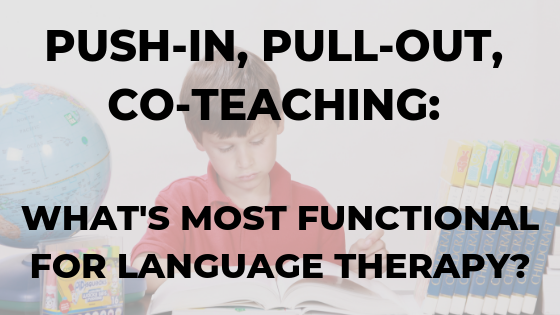I get a lot of questions about how to write functional language goals, as well as how to improve language and vocabulary with “functional” activities.
Usually the underlying question behind all of these surface-level questions is this:
“How do I make sure my therapy will yield results in real-life situations outside my sessions.”
OR
“How do I know my students are actually going to use these skills once they leave my room?”
The problem is there are a lot of myths about what we need to do to achieve this allusive “functionality” so our students generalize.
Co-teaching and “push-in” therapy are great examples.
Many of us assume that our students won’t generalize if we do pull-out therapy.
This can be the case, SOME of the time. But it isn’t always true.
Myths like this can make our jobs even more demanding, confusing, and stressful.
But debunking a couple of these misconceptions can eliminate that struggle and set you up to as an authority in your setting.
So let’s dive in to a couple of those misconceptions about “functional therapy” when it comes to boosting language comprehension and processing.

Myth #1: The only way to build high-level comprehension/cohesion skills is to work on them directly.
Let’s say you have a student who struggles to retell stories using correct story structure, or you have a student who can’t state the main idea of stories he’s read or heard.
You’d think that the #1 thing you’d be doing in therapy is working on high-level cohesion and comprehension…for example having them answer comprehension questions or retell stories.
That would be “functional”, right? Because we’re working on the “end goal”?
Not exactly.
These high-level comprehension skills, like “stating the main idea”, “drawing inferences”, or retelling an entire story at once are kind of like swimming in the deep end.
There are a lot of discrete skills being applied all at once.
If just one of them is out of place, the whole thing falls apart.
If they lack the semantic knowledge of words in the story, or if the sentence structure doesn’t make sense to them, there’s no way they’re going to be able to have that high-level comprehension we’re shooting for.
Comprehension is not just a single skill.
Instead, it’s a set of skills we use all at the same time.
And when our students aren’t able to put it all together we’re not doing them any favors by skimming over the pieces involved and letting them drown.
According to Scott (2009) the cause of general comprehension problems is often tied to underlying semantic and syntactic difficulties.
There’s also a body of evidence that shows that if we don’t address underlying deficits in lexical and syntactic knowledge, students may not be capable of benefiting from general comprehension strategies and high-level cohesion that requires them to “put it all together” (Gillon & Dodd, 1995; Nippold, 2017).
This is exactly why jumping right to a co-teaching setting isn’t always best for our students who need that structured focus on specific skills in order to build a foundation.
So what does this mean?
That on the surface, targeting word meanings and digging in to metalinguistic knowledge like grammar and syntax may seem less “functional” compared to comprehension strategies and high-level cohesion tasks like storytelling.
But they actually might be the most “functional” thing we can do for our students, because you’d be addressing the root cause of the comprehension issues in the first place.
When we’re thinking of these skills (e.g., semantics, syntax, grammar, morphology) within the context of narratives they’re often referred to as “microstructure” (Gillam et al., 2012).
Now is there a time and place for classroom-based intervention and work on high-level cohesion, like macrostructure?
Absolutely, and the key to functionality and generalization is knowing how to strike that subtle balance.

Myth #2 Therapy isn’t “functional” if we’re not working on the exact skills students do in class.
This second point builds on the first.
There are a lot of things that teachers work on in the general education classroom that benefit the majority of students.
However, we know that students on our caseload aren’t in that majority…hence the reason they’re on our caseloads.
That means that whatever was going on in the classroom wasn’t enough for them to make adequate progress.
This might include things like comprehension strategies, answering problem-solving and inferential reasoning questions, or telling stories with all the correct story elements (often what we refer to as “story grammar”).
All of these are great things.
For MOST students. Remember that your students are on your caseload because the general education instruction wasn’t working for them.
If you just repeat what’s being done in class, you’re essentially doing more of what didn’t work.
You could be working on the SYMPTOM (e.g., poor comprehension, weak retelling abilities), instead of the root cause.
This again, builds a case for why pull-out therapy can be just as effective if not more than push-in (as long as you have good collaboration with the teachers).
If our students are going to make progress, we need to do something DIFFERENT to fill in the gaps.
And since we know that students need the underlying linguistic knowledge to be able to perform those high-level “functional” tasks…we need to build some of those foundational skills causing the breakdowns in the first place.
Again, if we are talking about skills such as narratives, a lot of these elements fall in that “microstructure” category.
Things like grammar, syntax, and vocabulary.
What does this mean for you as the SLP?
Making your therapy “functional” is about helping your students make true progress.
And that means our therapy might look a little different from those “real-life” settings where we ultimately want them to improve because we’re filling in the gaps.
Once you build that foundation, only then do we need to make that transition to more challenging strategies like narratives and high-level cohesion.

Myth #3 “Pull out therapy” isn’t functional.
This is one of the biggest myths out there.
It can be true SOME of the time, but pull-out therapy is highly underrated; especially for students who need that level of intensity.
In many cases, it’s not the service-delivery model that’s the problem. It’s the way it’s implemented.
There’s new research coming out all the time about service-delivery models, but many studies have found that there isn’t one clear winner that trumps the rest of them (Cirrin et al., 2010).
What IS a key factor in effectiveness is good collaboration between staff; possibly because it helps keep therapy aligned and focused on the right skills, strategies, and supports (Throneburg et al., 2000).
In other words, making therapy functional is less about whether you’re pushing in or pulling out.
It’s more about focusing on the RIGHT skills in the RIGHT contexts; and keeping all stakeholders on the same page.
If you’re able to create the right kind of environment in therapy, being in a “pull-out” setting isn’t going to make you any less effective than physically being in the classroom.
Many times it’s actually a better option because it allows students to have fewer distractions, and can allow them to have more opportunities to practice certain skills.
But here’s the caveat: We don’t want to throw the baby out with the bathwater.
Being married to the “pull-out” model 100% of the time isn’t good either because there are times when we SHOULD focus on skills like high-level comprehension, summarizing, and cohesion.
And many times, doing this in the classroom allows us to give our students that one final push if they aren’t fully generalizing with more structured work.
A lot of students can make massive breakthroughs with intervention that addresses elements of vocabulary alone (like I teach in Language Therapy Advance).
For those students, this foundational work can have a domino effect that will make things click as they work on those high-level skills in the general education curriculums.
But some kids need us to take that extra step and reinforce those comprehension or narrative skills; and in these cases it does make sense to try to get in to the classroom.
The challenge is figuring out when this is needed and how to actually do it.
The problem is that many of us have been trained as clinicians and not teachers.
So not only is our role a bit muddled when it comes to language and literacy; we often don’t have a framework for “pushing-in” to the classroom the right way.
My first attempt at “co-teaching” was a complete trainwreck.
I wandered around the classroom like an untrained volunteer.
My therapy ended up being watered-down, and my students didn’t get the help they needed.
In my head I was thinking:
“I’m pushing in, now what?”
“What if I look like a complete moron fumbling around in here?”
“What are my colleagues going to think and what if my students never improve!”
The first step in doing this the right way is creating a solid foundation for language therapy in the first place.
That’s exactly what I help my SLPs do in Language Therapy Advance.
SLPs who join the program learn the framework I used to not just help my students reach their full potential…but to do it:
…Without working on every single worksheet teachers would send to speech with kids…
…Without spending hours drilling skills my students hated working on (like stating the main idea and answering inferencing questions)…
…Without teaching students every single vocabulary word they didn’t know…
…Even though I was working with mixed groups for only 30-40 minutes a week…
…Even with a huge caseload…
…Without reinventing the wheel for each individual language case…
…And without burning myself out in the process.
With the right system it’s possible for you to do the same.
What if you could:
… Cut your to-do list in half, and get still get groundbreaking results with your students?
… Leave work at a reasonable hour, get your nights and weekends back, and STILL see your students thrive?
… Be seen as a “go-to” language expert instead of the “speech teacher”?
… Spend less time digging through materials and research, and more time focusing on helping your students?
… Wake up recharged and 100% confident in your language therapy agenda on Monday morning?
If that sounds good to you, join the waiting list to learn when Language Therapy Advance enrollment is open.
References:
Scott, C. M. (2009). A case for the sentence in reading comprehension. Language, Speech, and Hearing Services in Schools, 40, 184-191. doi: 10.1044/0161-1461(2008/08-0042)

